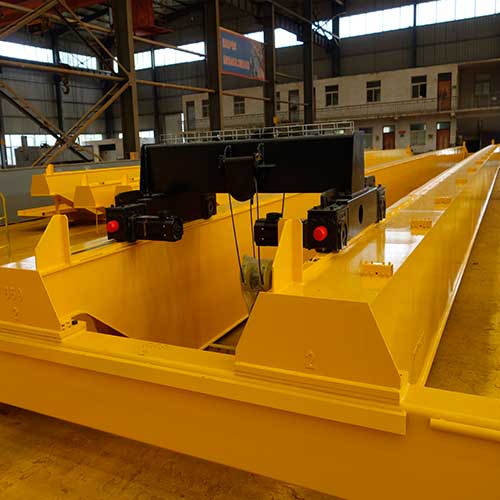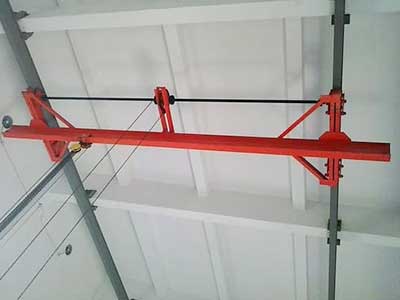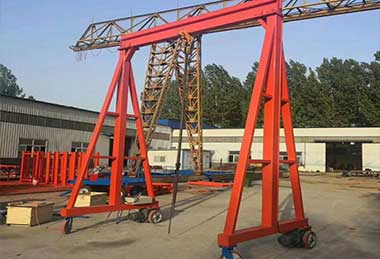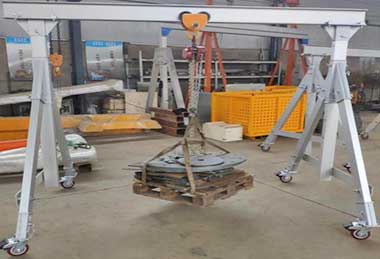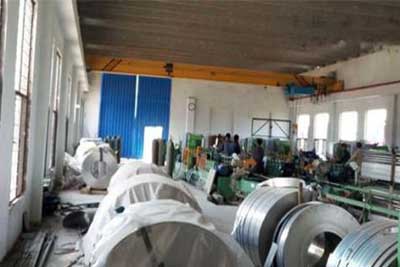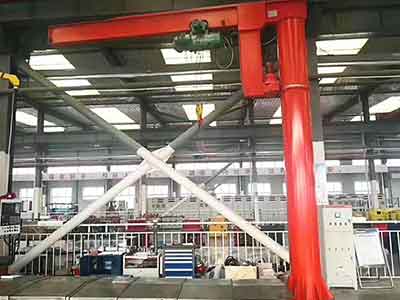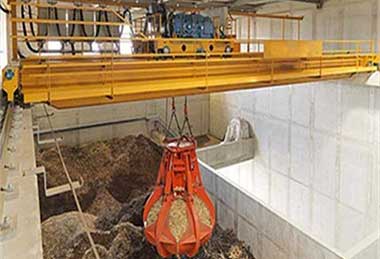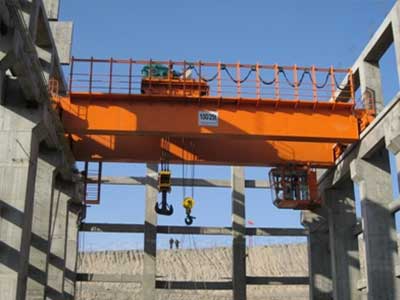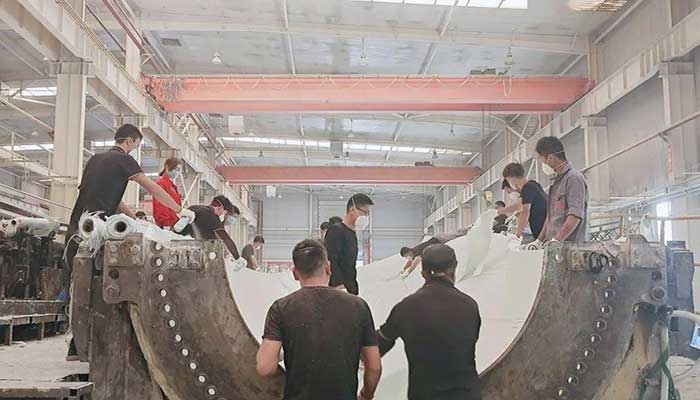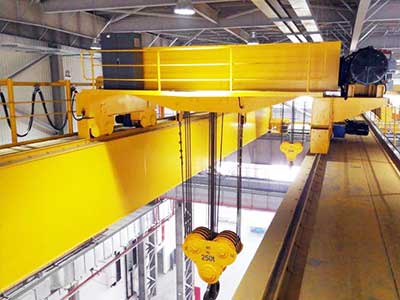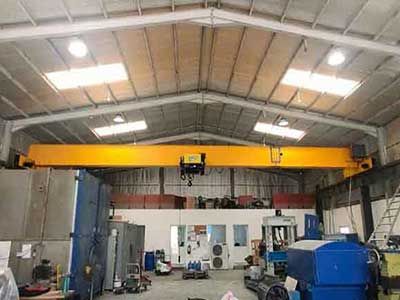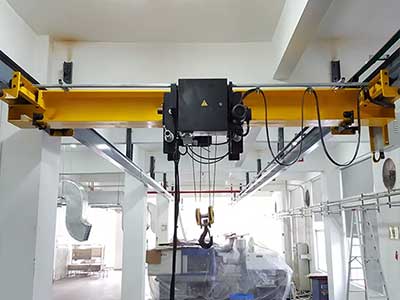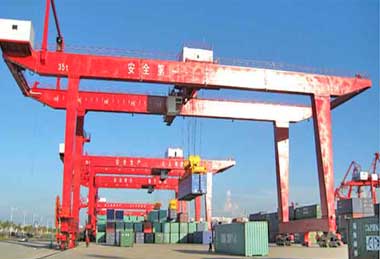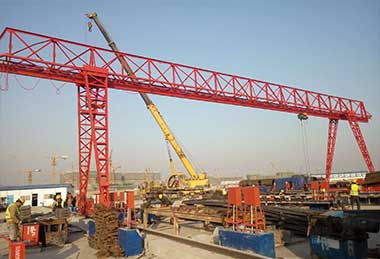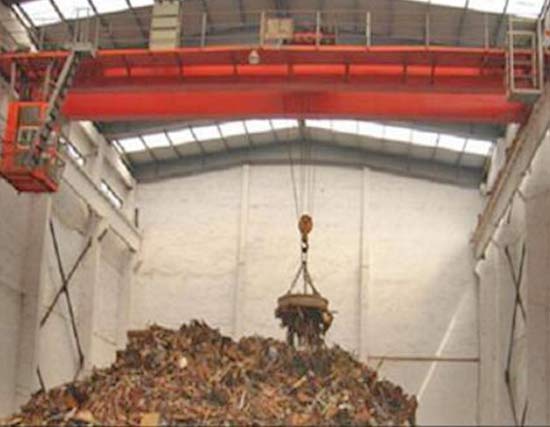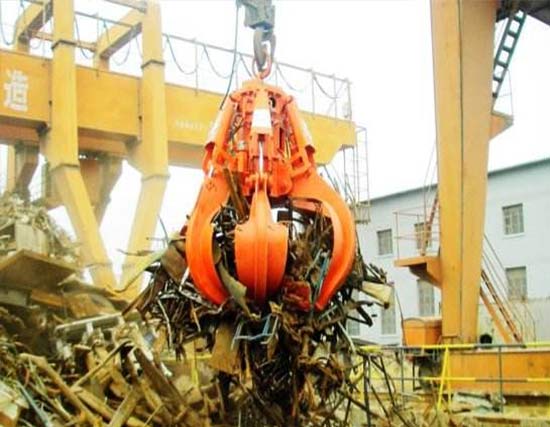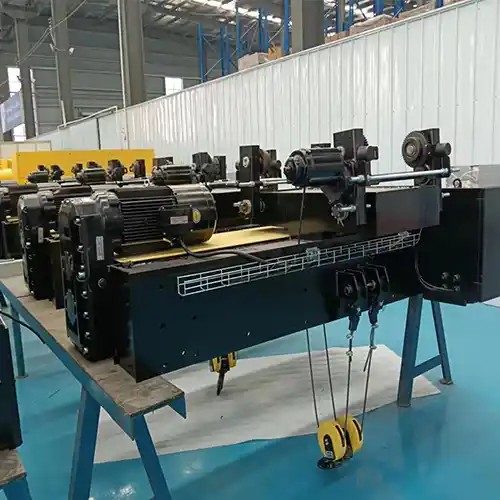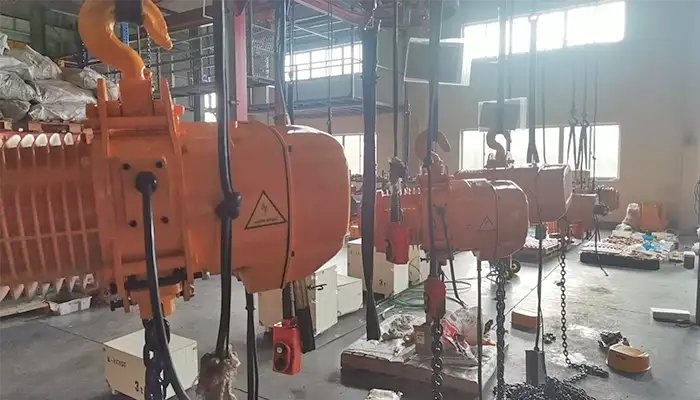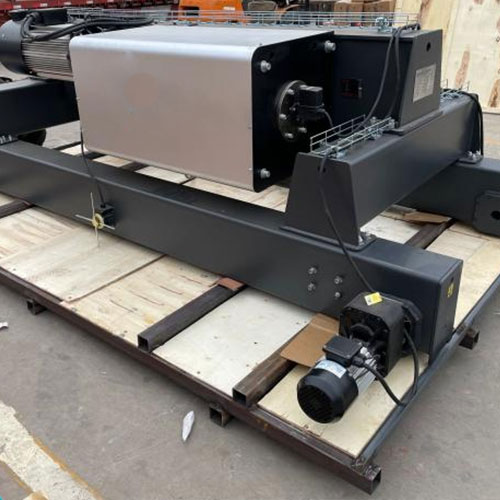Maximizing Overhead Cranes & Gantry Crane Lifespan: A Comprehensive Guide
How to make the best use of your overhead cranes & gantry cranes in workshops & warehouses? Check measures to maximize eot crane & goliath crane lifespan.
Category: Featured
Your Trusted Electric Overhead Cranes & Gantry Cranes Manufacturer & Supplier
Maximizing Overhead Cranes & Gantry Crane Lifespan: A Comprehensive Guide
How to make the best use of your overhead cranes & gantry cranes in workshops & warehouses? Check measures to maximize eot crane & goliath crane lifespan.
Maximizing Overhead Cranes and Gantry Crane Lifespan: A Comprehensive Guide
In the dynamic landscape of industrial operations, the reliability and durability of overhead and gantry cranes play a pivotal role in ensuring seamless processes and enhanced safety standards. In this comprehensive guide, we delve into the critical aspects influencing the lifespan of these cranes, exploring practical measures to optimize their performance and durability.
Overhead and gantry cranes are indispensable workhorses in various industrial settings, serving as the backbone for material handling and lifting operations. These cranes come in different configurations, including bridge cranes, gantry cranes, and workstation cranes, each tailored to specific operational needs. Their versatility makes them essential across a spectrum of industries, from manufacturing and construction to logistics and beyond.
Significance of Durability in Industrial Settings
The significance of crane durability cannot be overstated. Industrial processes rely on the continuous and reliable functioning of overhead and gantry cranes for efficient material movement and production flow. Downtime due to crane failure not only disrupts operations but also poses safety risks. Therefore, maximizing the lifespan of these cranes is a strategic imperative for ensuring operational continuity and minimizing maintenance costs.
Factors Influencing Crane Durability
Understanding the multifaceted factors that influence crane durability is crucial for proactive maintenance and longevity. Let's explore these key factors:
- Material Quality:The durability of a crane starts with the quality of materials used in its construction. High-quality steel for structural components and reliable materials for bearings and electrical components contribute to overall longevity.
- Design and Engineering:A crane's design and engineering determine its load capacity, structural integrity, and resistance to fatigue. Proper consideration of these factors during the design phase ensures a crane is built to withstand its intended operational demands.
- Maintenance Practices:Regular maintenance is the lifeblood of crane durability. Timely lubrication, thorough inspections, and prompt repairs are essential to prevent wear and tear, extending the crane's operational life.
- Operating Conditions:The environment in which a crane operates significantly affects its durability. Exposure to harsh weather conditions, corrosive atmospheres, or extreme temperatures can accelerate wear and require tailored maintenance practices.
- Load Capacity and Usage:Adhering to specified load capacity guidelines and avoiding overloading are critical for preventing structural damage and ensuring the crane operates within its designed parameters.
- Upgrades and Retrofits:Modernization through upgrades and retrofits enhances a crane's durability by incorporating technological advancements and safety features, keeping it aligned with evolving industry standards.
- Manufacturer Reputation:Choosing cranes from reputable manufacturers adds a layer of assurance regarding quality and performance. A manufacturer's track record and adherence to industry standards contribute to the overall reliability of their crane models.
As we navigate through the intricacies of crane durability, the next sections will delve into specific design lives for different crane types and actionable measures to maximize their lifespan in real-world industrial scenarios. Stay tuned for practical insights and guidelines in the upcoming parts of our guide.
Understanding Working Duty Classes for Overhead and Gantry Cranes
In the filed f overhead and gantry cranes, a nuanced classification system based on working duty provides insights into their intended use, usage intensity, and the environmental conditions they can withstand. In this section, we delve into the four main working duty classes—A1~A3, A4~A5, A6~A7, and A8—shedding light on their respective characteristics.
Classification of Cranes Based on Working Duty
Explanation of Working Duty Classes (A1~A3, A4~A5, A6~A7, A8)
Working duty classes are a standardized system categorizing cranes based on their expected load capacity, usage frequency, and the severity of operational conditions. Understanding these classes is pivotal for selecting the right crane for a specific industrial application:
A1~A3 Light-duty Series:
Primarily used for rare or infrequent operations.
Examples include manually operated cranes with a design life of 30 years.
A4~A5 Medium-duty Series:
Suited for less frequent use and moderate operational conditions.
Cranes designed for workshop assembly fall into this category, with a design life of 25 years.
A6~A7 Heavy-duty Series:
Deployed in severe operating conditions with more frequent use.
Examples include gantry cranes in railway station freight yards, with a design life of 20 years.
A8 Extremely Severe Operating Conditions:
Reserved for cranes exposed to the harshest conditions, often in metallurgical processes.
Typically, these cranes have a design life of within 20 years.
Click to leanrm more How to Determine Your Hoist and Crane Duty Classification? As for the typical working life of an overhead cranes and gantry cranes, please consult your cranes and hoists supplier and manufacturer. As for your electric hoists and cranes lifespan provided by our factory, please feel free to contact us by leaving a message down blow.
Description of Usage Intensity and Conditions for Each Class
Understanding the usage intensity and conditions for each working duty class is crucial for aligning crane selection with operational requirements:
A1~A3 Light-duty Series:
Ideal for rare operations where the crane is sparingly used.
Designed to withstand infrequent stress, offering a longer design life of around 40 years.
A4~A5 Medium-duty Series:
Suited for less frequent use but under moderate conditions.
These cranes undergo a design life of around 30 years, with major repairs extending their lifespan.
A6~A7 Heavy-duty Series:
Thrives in more severe operating conditions with frequent use.
Designed for a shorter lifespan, averaging around 20 years, with major repairs contributing to longevity.
A8 Extremely Severe Operating Conditions:
Reserved for cranes subjected to the most demanding conditions, especially in metallurgical processes.
These cranes typically have a design life within 20 years and may require mandatory scrapping after reaching the end of their service life.
As we move forward, the guide will explore the actual service life statistics for each working duty class and delve into actionable measures to enhance the durability and lifespan of overhead and gantry cranes in diverse industrial settings. Stay tuned for insights that bridge theory with practical applications.
Commonly Used Design Life for Different Types of Cranes
Manual Operated Cranes:
Manual operated cranes, featuring simplicity and versatility, cater to scenarios where human control is paramount. Understanding their design life involves a closer look at critical factors that define their durability.
- Total Working Cycles:The total working cycles of manual operated cranes, referring to the number of completed lifting and lowering operations, are estimated to range between 3.2×10^4 to 6.3×10^4. This range reflects the cranes' capability to endure a substantial number of cycles throughout their operational lifespan.
- Usage Frequency:Manual operated cranes are designed for scenarios where their usage is rare. Infrequent deployment aligns with their role in tasks that require manual control but occur sporadically within the industrial setting.
- Design Life: 30 years:The design life of manual operated cranes is a noteworthy 30 years. This extended period speaks to their robust construction and the ability to withstand the test of time. The durability is attributed to the infrequent use and the manual nature of their operation, contributing to a longer operational lifespan.
As we explore the intricacies of crane design life, the subsequent sections will delve into various crane types, each presenting its unique characteristics and lifespan expectations. Stay engaged as we unravel more insights into the world of overhead and gantry cranes, providing a comprehensive guide for industry professionals and enthusiasts alike.
Overhead Cranes for Workshop Assembly:
Cranes tailored for workshop assembly bring a specialized touch to the manufacturing environment. Let's delve into the key parameters that define their design life of workshop cranes:
- Total Working Cycles:The total working cycles for cranes used in workshop assembly are estimated to range from 6.3×10^4 to 1.25×10^5. This range underscores the versatility of these cranes, capable of handling a moderate to high number of working cycles over their operational lifespan.
- Usage Frequency:Cranes deployed for workshop assembly exhibit a less frequent usage pattern. This aligns with their role in handling tasks associated with assembling components and products, typically occurring at a moderate frequency within the workshop environment.
- Design Life: 25 years:The design life of cranes dedicated to workshop assembly is set at 25 years. This period reflects the balance between their workload and the durability required for consistent performance over an extended timeframe. The design life takes into account the less frequent but moderate usage, ensuring reliability in workshop settings.
As we continue our journey through the intricacies of crane design life, the subsequent sections will further dissect various crane types, each offering unique insights into their operational characteristics and expected lifespan. Stay tuned for a comprehensive guide that navigates the complexities of overhead and gantry cranes, providing valuable information for industry professionals and enthusiasts alike.
Overhead Cranes for Power Stations and Maintenance:
Cranes specifically engineered for power stations and maintenance serve unique roles in handling heavy loads and facilitating essential upkeep. Let's delve into the specific parameters that define their design life:
- Total Working Cycles:The total working cycles for cranes used in power stations and maintenance activities are estimated to range from 3.2×10^4 to 6.3×10^4. This range underscores their versatility, capable of completing a substantial number of working cycles while ensuring reliable and consistent performance.
- Usage Frequency:The usage frequency for these cranes varies based on the specific application:
Rarely Used: In scenarios where cranes are rarely deployed, the design life extends to an impressive 30 years.
Less Frequently Used: For cranes with a less frequent usage pattern, the designated design life is set at 25 years. These cranes strike a balance between durability and usage frequency, ensuring longevity in less demanding operational scenarios. - Design Life: 30 years (rarely used), 25 years (less frequently used):The design life of cranes for power stations and maintenance is a dynamic aspect, adapting to the specific demands of their operational context. With a design life of 30 years for rarely used instances and 25 years for less frequent usage, these cranes are engineered to withstand the challenges posed by power generation environments and maintenance tasks.
As our exploration into crane design life continues, the subsequent sections will unravel more facets of overhead and gantry cranes, providing valuable insights for industry professionals and enthusiasts seeking a deeper understanding of these essential industrial workhorses. Stay engaged for a comprehensive guide that bridges theory with practical applications.
Workshop Cranes (Including European Style Electric Hoist Cranes)
Workshop cranes, often equipped with electric hoists, are integral to manufacturing and assembly processes. Let's dissect the key parameters defining their design life:
- Total Working Cycles:The total working cycles for workshop cranes, including electric hoist cranes, range from 6.3×10^4 to 1.25×10^5. This range highlights their adaptability to moderate to high working cycles, making them suitable for diverse applications within workshop settings.
- Usage Frequency:Workshop cranes exhibit varying usage patterns based on the specific application:
Less Frequently Used: Cranes with a less frequent usage pattern are designed to endure 25 years of service.
Infrequent Light-Duty Use: In scenarios involving infrequent light-duty use, the designated design life is set at 20 years.
Infrequent Medium-Duty Use: For cranes handling infrequent medium-duty tasks, the design life extends to 25 years. These cranes strike a balance between durability and usage frequency, ensuring longevity in diverse workshop scenarios.
Hook Cranes for Freight Yards
Hook cranes tailored for material handling in workshops and freight yards play a pivotal role in material handling. Let's explore the specific parameters that define their design life:
- Total Working Cycles:The total working cycles for hook cranes used in freight yards and cargo handling range from 1.25×10^5 to 5×10^5. This range signifies their capability to handle a substantial number of working cycles while ensuring efficiency in material transport.
- Usage Frequency:Hook cranes for freight yards showcase usage patterns based on the specific application:
Less Frequently Used: Cranes with less frequent usage patterns are designed to endure 25 years of service.
More Frequent Medium-Duty Use: In scenarios involving more frequent medium-duty tasks, the designated design life is set at 20 years. These cranes are engineered for efficiency in handling moderate loads in diverse freight yard applications.
As our exploration into crane design life continues, the subsequent sections will unravel more facets of overhead and gantry cranes, providing valuable insights for industry professionals and enthusiasts seeking a deeper understanding of these essential industrial workhorses. Stay engaged for a comprehensive guide that bridges theory with practical applications.
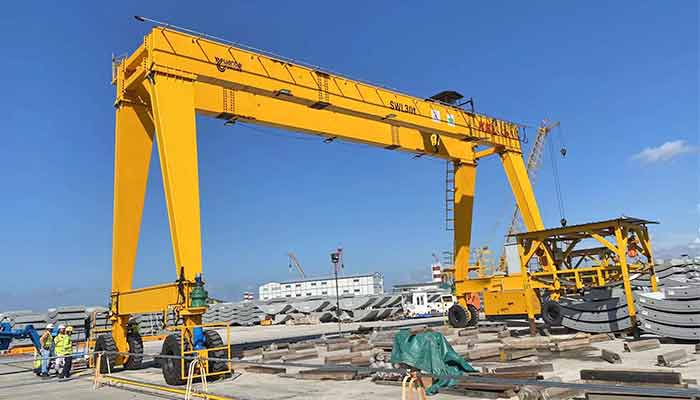
Rubber tyred gantry crane with a frame design and u frame design for port use
Waste Plant and Metallurgic Cranes
Cranes deployed in waste plants and metallurgic processes play a crucial role in handling heavy loads and enduring demanding conditions. Let's delve into the key parameters that define their design life:
- Total Working Cycles:The total working cycles for waste plant and metallurgic cranes range from 1.25×10^5 to 2.5×10^5 for less frequent use, 2.5×10^5 to 5×10^5 for more frequent medium-duty use, and 1×10^6 to 2×10^6 for frequent heavy-duty use. This diverse range reflects the adaptability of these cranes to handle a broad spectrum of working cycles in challenging environments.
- Usage Frequency:The usage frequency for these cranes varies based on the specific application:
Less Frequently Used: Cranes with less frequent usage patterns are designed to endure 25 years of service.
More Frequent Medium-Duty Use: In scenarios involving more frequent medium-duty tasks, the designated design life is set at 20 years. These cranes are engineered for efficiency in handling moderate loads in diverse waste plant applications.
Frequent Heavy-Duty Use: Cranes subjected to frequent heavy-duty tasks have a variable design life, generally ranging from 10 to 15 years. The shorter lifespan is attributed to the intense operational demands and stresses experienced in metallurgical processes.
As our journey into the intricacies of crane design life progresses, the subsequent sections will unravel more facets of overhead and gantry cranes, providing valuable insights for industry professionals and enthusiasts seeking a deeper understanding of these essential industrial workhorses. Stay engaged for a comprehensive guide that bridges theory with practical applications.
Enhancing Crane Resilience: Factors Affecting Durability
As we navigate the complexities of overhead and gantry cranes, understanding the factors influencing their durability is paramount. In this section, we delve into key aspects such as material quality and design and engineering considerations, shedding light on the importance of each factor in ensuring the longevity and resilience of these industrial workhorses.
Factors Affecting Crane Durability
Material Quality:
Material quality is a cornerstone in determining the durability of overhead and gantry cranes. Let's explore the critical components that contribute to material quality:
- Importance of High-Quality Steel:The structural components of a crane, primarily constructed from high-quality steel, lay the foundation for its durability. High-grade steel ensures robustness, resistance to wear, and the ability to withstand the operational stresses encountered in various industrial settings.
- Bearings and Electrical Components:Beyond structural elements, the durability of a crane hinges on the quality of its bearings and electrical components. Reliable bearings contribute to smooth operation, while durable electrical components enhance the crane's overall performance and longevity.
Design and Engineering:
The design and engineering of a crane are pivotal factors in determining its load capacity, structural integrity, and resistance to fatigue. Let's delve into specific considerations within this realm:
- Considerations for Load Capacity:The design phase must meticulously account for the crane's intended load capacity. Engineers must calculate and optimize load-bearing capabilities, ensuring that the crane can safely and efficiently handle the specified weights within its operational parameters.
- Structural Integrity and Fatigue Resistance:Structural integrity is non-negotiable for crane durability. Ensuring that the crane's components are well-designed and properly connected enhances its ability to resist fatigue and withstand the repetitive stresses induced by lifting and lowering operations. Robust engineering in this regard contributes to extended service life.
As we progress through the exploration of factors influencing crane durability, the subsequent sections will delve into additional considerations such as maintenance practices, operating conditions, and load capacity, providing a holistic understanding for industry professionals and enthusiasts alike. Stay tuned for practical insights that bridge theory with real-world applications.
Maintenance Practices
Effective maintenance practices are the lifeline of overhead and gantry cranes, ensuring their sustained performance and longevity. Let's delve into key practices that contribute to crane durability:
- Importance of Regular Lubrication:Regular and proper lubrication is essential for the smooth operation of crane components. Adequate lubrication reduces friction, minimizes wear and tear, and prevents premature failure of critical parts. A well-lubricated crane operates efficiently and extends its overall lifespan.
- Inspection and Timely Repairs:Routine inspections are crucial for identifying potential issues before they escalate. Regular checks on components, such as hooks, ropes, and electrical systems, enable timely detection of wear, damage, or malfunction. Swift repairs and replacements, based on inspection findings, prevent the development of more significant problems and contribute to the crane's overall durability.
Operating Conditions
The operating conditions under which cranes function have a profound impact on their durability. Let's explore specific considerations related to operating conditions:
- Impact of Harsh Weather Conditions:Cranes exposed to harsh weather conditions, including extreme temperatures, high winds, or heavy precipitation, face additional challenges. These conditions can accelerate wear, corrosion, and fatigue, emphasizing the need for robust design and maintenance practices to mitigate their adverse effects.
- Corrosive Atmospheres and Their Effects:In industrial settings with corrosive atmospheres, such as those found in chemical plants or coastal areas, cranes are susceptible to corrosion. Corrosion weakens structural components and compromises the crane's integrity. Comprehensive measures, including protective coatings and regular inspections, are vital to combat the corrosive effects of the environment.
As we advance in our exploration of factors influencing crane durability, the subsequent sections will delve into load capacity considerations, upgrades and retrofits, and the reputation of manufacturers. Stay engaged for a comprehensive guide that provides valuable insights for industry professionals and enthusiasts alike.
Load Capacity and Usage
Load capacity and adherence to specified limits are pivotal aspects in ensuring the longevity and reliability of cranes. Let's delve into the nuances of load capacity and its implications on crane durability:
- Adherence to Specified Load Capacity :Ensuring strict adherence to the specified load capacity is fundamental for crane durability. Operating within the designated limits prevents overstressing of components, minimizes wear, and safeguards against structural damage. Regular monitoring of loads and compliance with capacity guidelines contribute to sustained performance.
- Implications of Overloading :Overloading a crane poses severe risks to its structural integrity and overall durability. The implications of overloading include accelerated wear on mechanical components, increased stress on structural elements, and a heightened risk of catastrophic failure. Strict adherence to load capacity guidelines is paramount to avoid these detrimental effects.
Upgrades and Retrofits
The ability to adapt and enhance crane capabilities over time is a key factor in maximizing durability. Let's explore the significance of upgrades and retrofits in extending the service life of overhead and gantry cranes:
- Modernization for Enhanced Durability :Modernization initiatives, encompassing technological upgrades and improvements, contribute to enhanced crane durability. Integration of advanced control systems, precision components, and automation technologies not only improves performance but also extends the operational lifespan of the crane.
- Safety Feature Additions :Incorporating additional safety features through retrofits enhances the overall durability of cranes. Upgrades such as advanced collision avoidance systems, emergency braking mechanisms, and improved monitoring capabilities contribute to a safer operational environment, reducing the risk of accidents and potential damage to the crane.
As our journey into the intricacies of crane durability unfolds, the subsequent sections will explore the reputation of manufacturers and the critical considerations involved in determining when a crane needs to be scrapped. Stay tuned for a comprehensive guide that provides actionable insights for industry professionals and enthusiasts alike.
Manufacturer Reputation
As we approach the final aspects of our comprehensive guide on overhead and gantry crane durability, we delve into the crucial influence of manufacturer reputation and historical performance on the reliability and longevity of these industrial workhorses.
The reputation of the manufacturer plays a pivotal role in determining the quality and durability of overhead and gantry cranes. Let's explore the key considerations associated with manufacturer reputation:
- Choosing Reputable Manufacturers:Selecting cranes from reputable manufacturers is a foundational step in ensuring durability. Reputable manufacturers have a track record of producing high-quality, reliable, and well-engineered cranes. Prioritizing established names in the industry provides confidence in the product's construction, performance, and adherence to safety standards.
- Historical Performance of Crane Models:A critical aspect of assessing manufacturer reputation is examining the historical performance of specific crane models. This involves studying the real-world durability, reliability, and longevity of cranes produced by a manufacturer. Insights into how well a particular model has fared in diverse industrial settings over time contribute to informed decision-making during the procurement process.
As we conclude our exploration into the factors influencing crane durability, the subsequent sections will address the pivotal question of when a crane needs to be scrapped. This essential knowledge ensures that operators can make informed decisions regarding the retirement of cranes to maintain safety and operational efficiency. Stay tuned for the final segment of our comprehensive guide, providing actionable insights for industry professionals and enthusiasts alike.
Prolonging Lifespan: Proactive Measures for Crane Durability
In the concluding section of our comprehensive guide on overhead and gantry crane durability, we explore proactive measures that operators can undertake to maximize the lifespan and performance of these crucial industrial assets.
Regular Maintenance Programs
Implementing regular maintenance programs is a cornerstone for ensuring the long-term durability of overhead and gantry cranes. Let's delve into key components of effective maintenance:
- Scheduled Lubrication and Inspection:Scheduled lubrication is essential for reducing friction and minimizing wear on moving parts, ensuring smooth operation. Regular inspections, conducted at planned intervals, allow for the early detection of potential issues. This proactive approach helps address concerns before they escalate, contributing to extended crane life.
- Prompt Repairs and Replacements:Promptness in addressing issues identified during inspections is crucial. Whether it's repairing worn-out components or replacing parts nearing the end of their service life, swift actions prevent the development of more significant problems. A proactive stance toward repairs ensures that the crane operates at optimal efficiency and reliability.
As we conclude our comprehensive guide on overhead and gantry crane durability, the knowledge and insights provided are geared towards empowering industry professionals and enthusiasts. By understanding the intricacies of crane design life, factors influencing durability, and proactive measures for maintenance, operators can make informed decisions to maximize safety, efficiency, and the overall lifespan of these indispensable industrial workhorses. Thank you for joining us on this exploration, and may your crane operations be marked by longevity and excellence.
Adherence to Load Capacity Guidelines
Strict adherence to load capacity guidelines is paramount for the sustained durability of cranes. Let's delve into the key components of load capacity management:
- Avoiding Overloading:A fundamental measure to maximize crane durability is avoiding overloading. Operating within the specified load limits prevents excessive stress on components, mitigates wear, and safeguards against structural damage. Consistent training and adherence to load capacity guidelines by operators are critical for crane longevity.
- Regular Load Testing:Regular load testing is an essential practice to verify the crane's load-handling capabilities. Conducting scheduled load tests ensures that the crane continues to meet its specified load capacity. This proactive measure provides valuable insights into the crane's performance under different load conditions, allowing for adjustments or repairs as needed.
Upgrades and Modernization
Keeping cranes updated with technological advancements and safety features contributes significantly to their overall durability. Let's explore the proactive measures associated with upgrades and modernization:
- Implementing Technological Advancements:Incorporating the latest technological advancements enhances the efficiency and reliability of cranes. Upgrades such as advanced control systems, real-time monitoring, and automation technologies not only improve performance but also extend the operational lifespan of the crane.
- Retrofitting for Improved Safety and Efficiency:Retrofitting involves adding new features or components to existing cranes to enhance their safety and efficiency. This can include the integration of modern safety systems, improved controls, or energy-efficient components. Retrofitting ensures that older cranes can benefit from contemporary innovations, contributing to their extended durability.
Environmental Considerations
Environmental factors play a significant role in crane durability, particularly in challenging conditions. Let's explore proactive measures related to environmental considerations:
- Protective Coatings for Corrosion Prevention:In corrosive environments, applying protective coatings to crane components is a preventive measure against corrosion. Regular inspections and recoating as needed contribute to the crane's resilience in the face of corrosive atmospheres.
- Climate-Controlled Environments:Creating climate-controlled environments, especially in regions with extreme temperatures or high humidity, can significantly impact crane durability. Temperature and humidity control mitigate the impact of environmental stressors, ensuring consistent performance and reducing wear on critical components.
As we conclude the extended exploration of measures to maximize crane durability, these proactive steps provide a comprehensive approach for industry professionals to optimize the performance and longevity of overhead and gantry cranes. May these insights guide operators towards maintaining safe, efficient, and durable crane operations.
Actual Service Life Statistics: Real-world Insights into Crane Longevity
In this segment, we shift our focus to the actual service life statistics of different series of overhead and gantry cranes, providing valuable insights into their performance and longevity under varying operating conditions.
A1~A3 Light-duty Series
Statistical Analysis:
Rigorous statistical analysis of A1~A3 light-duty series cranes reveals consistent performance and reliability.
The analysis includes factors such as usage frequency, maintenance practices, and environmental conditions.
Average Lifespan: Around 40 years
Based on real-world data, the average lifespan of A1~A3 light-duty series cranes is estimated to be around 40 years.
This remarkable longevity is attributed to their suitability for less demanding applications and effective maintenance practices.
A4~A5 Medium-duty Series
Statistical Analysis:
Thorough statistical analysis of A4~A5 medium-duty series cranes considers factors such as the frequency of major repairs, usage patterns, and load capacities.
The analysis provides a comprehensive understanding of how these cranes perform in diverse industrial settings.
Average Lifespan: Around 30 years (with major repairs), 25 years (with one major repair)
The average lifespan of A4~A5 medium-duty series cranes varies based on the intensity of use and maintenance practices.
Cranes subjected to major repairs within their operational life are estimated to have an average lifespan of around 30 years, while those with one major repair can endure for approximately 25 years.
A6~A7 Heavy-duty Series
Statistical Analysis:
In-depth statistical analysis of A6~A7 heavy-duty series cranes examines their performance under severe operating conditions, considering factors such as stress levels, maintenance intensity, and repair frequency.
Average Lifespan: Around 20 years (with major repairs), 17 years (with one major repair)
A6~A7 heavy-duty series cranes, designed for severe operating conditions, exhibit an average lifespan of around 20 years with major repairs and 17 years with one major repair.
These cranes demonstrate resilience in handling heavy-duty tasks but require meticulous maintenance to maximize their operational life.
A8 Extremely Severe Operating Conditions
Statistical Analysis:
The statistical analysis of A8 cranes, subjected to extremely severe operating conditions, provides insights into the challenges and durability factors unique to this category.
Average Lifespan: Within 20 years
Cranes operating in extremely severe conditions have an average lifespan within 20 years.
Due to the harsh environments they encounter, these cranes may face accelerated wear and require rigorous maintenance to ensure their longevity.
These real-world service life statistics offer a practical perspective for industry professionals, aiding in decision-making regarding crane selection, maintenance planning, and operational expectations. Understanding the nuances of different crane series empowers operators to optimize their usage and enhance overall efficiency.
When Does a Crane Need to be Scrapped?: Essential Criteria for Decision-Making
In this crucial section, we explore the decisive factors that guide the determination of when an overhead or gantry crane has reached the end of its service life. Understanding these criteria is fundamental for maintaining safety, efficiency, and compliance with industry standards.
Overhauls
- Regular Overhauls: Overhauls are essential maintenance activities to extend a crane's life. However, when a crane has undergone multiple overhauls, it raises concerns about the long-term viability and cost-effectiveness of further repairs.
- Diminishing Returns: If the frequency of overhauls increases, and the costs associated with each overhaul become prohibitively high, it may be a signal that the crane is approaching the end of its economic life.
Structural Integrity
- Deflection and Repairs: Structural integrity is paramount for crane safety. If the main beam of a crane has undergone multiple deflection repairs, it indicates that the structure may have reached its limits. Serious deflection or repeated cracks are red flags for structural issues.
- Weld Quality: Assessing the quality of welds and structural components is crucial. If welding repairs become recurrent or if there are signs of weld fatigue, it may signal a compromise in the crane's structural integrity.
Performance
- Meeting Operational Requirements: A crane must consistently meet operational requirements. If it no longer performs tasks efficiently or fails to meet safety standards even after repairs, it may be an indication that its functional life has been exhausted.
- Obsolete Technology: Advancements in crane technology may make older models obsolete. If obtaining spare parts becomes challenging due to discontinuation or if upgrades are impractical, it could influence the decision to retire the crane.
Corrosion Levels
- Coastal and Harsh Environments: Cranes operating in coastal areas or harsh environments are prone to corrosion. When the corrosion levels reach a point where they compromise the crane's structural integrity, it becomes a critical factor for considering scrapping.
- Comprehensive Analysis: Conducting a comprehensive analysis of corrosion, including measuring thickness loss in structural components, helps in assessing the severity. If the corrosion exceeds acceptable levels, scrapping may be the safest course of action.
Understanding these criteria and conducting a thorough assessment based on them is vital for making informed decisions about the retirement of overhead and gantry cranes. Prioritizing safety and efficiency ensures a smooth transition to newer, more reliable equipment and maintains the overall integrity of industrial operations.
Conclusion: Nurturing Crane Longevity for Sustainable Operations
As we conclude our comprehensive guide on maximizing the durability and service life of overhead and gantry cranes, we emphasize key takeaways that resonate with the importance of responsible management and strategic decision-making.
Importance of Monitoring Crane Performance
- Continuous Vigilance: The longevity and effectiveness of overhead and gantry cranes hinge on the vigilant monitoring of their performance. Regular assessments, including structural evaluations, load testing, and operational checks, are indispensable for identifying potential issues before they escalate.
- Performance Metrics: Establishing performance metrics and benchmarks ensures that any deviations from optimal functionality are promptly addressed. Early detection of issues allows for proactive measures, safeguarding both the crane and the overall industrial operation.
Commitment to Regular Maintenance for Maximizing Crane Life
- Proactive Maintenance Culture: A commitment to regular maintenance is the bedrock of extended crane life. Implementing proactive maintenance programs, including scheduled lubrication, inspections, and timely repairs, not only enhances durability but also reduces the risk of unexpected breakdowns.
- Leveraging Technological Tools: Embracing technological tools for condition monitoring and predictive maintenance contributes to the efficiency of maintenance practices. Data-driven insights enable operators to make informed decisions and optimize the overall performance of their crane fleet.
Balancing Operational Efficiency and Safety Considerations
- Holistic Approach: Striking a balance between operational efficiency and safety considerations is paramount. While efficiency enhances productivity, safety considerations are non-negotiable. Integrating safety protocols, modernization initiatives, and employee training ensures a holistic approach to crane management.
- Smart Investments: Decision-makers should view crane investments as long-term commitments. Considering factors such as working duty, operational demands, and environmental conditions facilitates smart investments that align with the unique requirements of specific industrial settings.
In the dynamic landscape of industrial operations, the durability of overhead and gantry cranes is not just a matter of mechanical performance; it is a reflection of a strategic and conscientious approach to equipment management. By prioritizing safety, committing to proactive maintenance, and embracing technological advancements, operators can navigate the challenges of crane management with confidence, ensuring sustainable and efficient industrial operations.
Main Projects
Related Products

Latest project
32/5 Ton Overhead Crane Sale in India: Case Study
Free consultation to Confirm Parameters & Specifications and Get
Latest Crane Price & Crane Rate.
- Types of overhead cranes : _______?
- Optional: Overhead travelling crane, goliath gantry crane,Slewing jib crane, Single girder or double girder crane,small portable crane or kbk crane, etc.
- Capacity of overhead crane: _______?
- Optional: 0.25ton, 0.5 ton, 1 ton, 2 ton, 3ton, 5 ton, 10 ton,15ton, 20ton, 25 ton, 30ton,35ton, up to 550ton, etc.
- Crane span & lifting height : _______?
- Crane travelling length : _____?
- Control of overhead crane:_______?
- Optional: pendant/ remote/cabin control
- Voltage supply of overhead crane:_____?
- Eg,: 380V50/60HZ,3Phase or others,etc.
- Application/usage of crane:_______?
- Eg,: Steel mill, ,injection mold, cement,stone, concrete,granite, general manufacturing, etc.
Just leave a message via the contact form and our hoist and crane engineer will contact you with in 24working hours.
Get In Touch
